Sensation and perception
1/97
There's no tags or description
Looks like no tags are added yet.
Name | Mastery | Learn | Test | Matching | Spaced |
|---|
No study sessions yet.
98 Terms
Sensation
detecting physical energy (sound waves, light waves, molecules, etc) in environment
form the basis for mental life
informs us whether to approach an object or to avoid an object
Perception
Interpreting sensations. Providing definition, categorization, understanding
Reception
The absorption of physical energy by receptors.
Receptors can either be specialized cells that change with physical energy or the dendrites of a sensory neuron itself
Transduction
Conversion of physical energy to an electrochemical pattern in the neurons (action potential).
Thresholds
Refers to how much stimulation is required before an action potential is generated
In reference to sensation, how much stimulation is required before sensory receptors respond. Two majors kinds in sensation/perception:
Absolute Threshold
minimum amount of stimulation required to detect a stimulus 50% of the time it is presented
Difference Threshold
minimum amount of additional stimulation that is required to notice a difference (either increase or decrease) in a stimulus 50% of the time
Sensory Adaptation
Our senses have evolved to detect CHANGES in our environment, rather than to invest in steady-state responding
Sensory adaptation refers to the change insensitivity that occurs when a sensory system is either stimulated or not stimulated for a period of time.
This can happen at the receptor level, or higher in sensory processing
Motion Aftereffect
the illusion of motion of a stationary object that occurs after prolonged exposure to a moving object
Signal Detection Theory
This is a line of research in probability which examines the payoff values of outcomes. The researcher presents a very faint signal and asks the participant whether or not the signal was present.
1. Is a signal actually present?◦ 2. Does the subject indicate the signal is present?
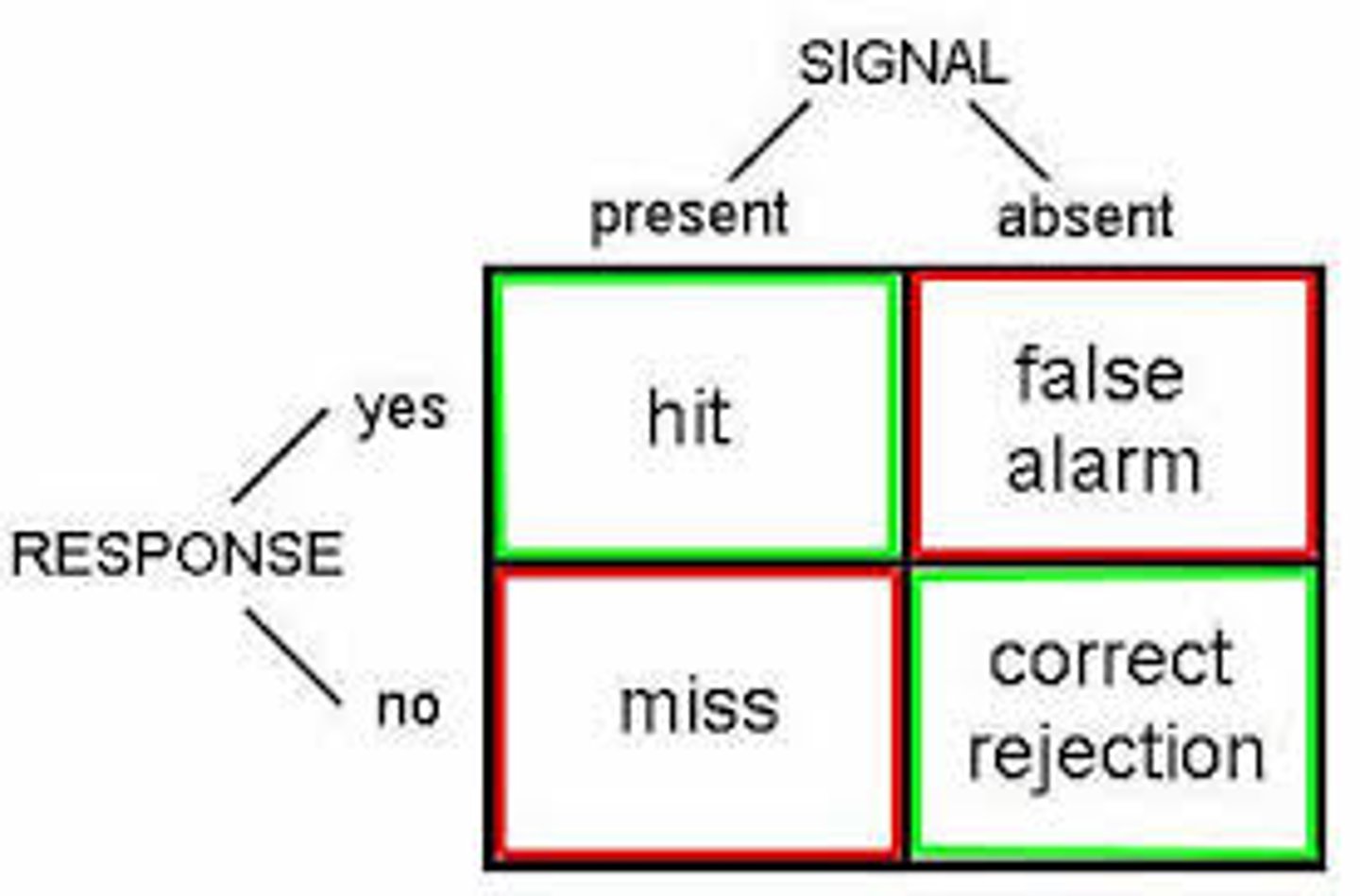
Visible Light
The portion of the electromagnetic spectrum that is detected by a human's photoreceptors.
It ranges from about 400 to 750 nanometers (nm).
◦ 400 nm perceived violet/blue
◦ 500 nm perceived green
◦ 700 nm perceived red
Iris
colored muscle surrounding the pupil; controls the amount of light entering the eye
Pupil
opening in the eye that light passes through
Lens
focuses light waves on the back of the eye. The process of bending the lens to focus images on the retina is call accommodation.
Retina
Light-sensitive lining of the back of the eye; contains photoreceptors; part of the brain
Fovea
area of central focus; many photoreceptors, few ganglion cells
Photoreceptors
light-sensitive; contain chemical that reacts to light waves. Two major types of photoreceptors:
◦ Rods
◦ Cones
Hit
When the signal is present and the participant correctly guesses it
Miss
When the signal is present and the participant says it is not present
False Alarm
When the signal is absent but the participant guesses that it is present
Correct Rejection
When the signal is absent and the participant correctly guesses that it is absent
Rods
120 million(in humans)
Mostly outside fovea
Highly sensitive to light
black/white/gray vision
"fuzzy" vision
Used in low light situations and are highly sensitive to light waves
Cones
6 million (in humans)
mostly at fovea
lower sensitivity to light
color vision
"acute" vision
Used in daylight situations and require higher intensities of light to activate
The Blind Spot
Area of eye where ganglion axons leave the eye; no photoreceptors are located here, thus we are "blind" in that area.
We don't notice it except in special situations because the visual system automatically "fills in "missing details and smoothes out the visual experience
Trichromatic theory(Young/Helmholtz)
Proposes three different types of cones, each maximally sensitive to different wavelengths of light
◦ Short wavelength —violet/blue
◦ Medium wavelength —green
◦ Long wavelength —orange/red
Ratio of firing from each type of cone determines color perception
Opponent-process theory(Hering)
At a higher level in organization of visual information, we perceive color in paired opposites
When "red" is activated, "green" is inhibited, and vice-versa.
When "blue" is activated, "yellow" is inhibited, and vice-versa.
When "black" is activated, "white" is inhibited, and vice-versa
Evidence for Trichromatic explanation
Color blindness: the lack of one or more type of cone; makes it impossible to distinguish between paired colors (red/green is most common; more rare is blue/yellow)
Evidence for Opponent Processes Explanation
The opponent-process is the basis of negative afterimages. Fatiguing one or the other of the opponent-process visual cells results in seeing the opponent color when viewing white light
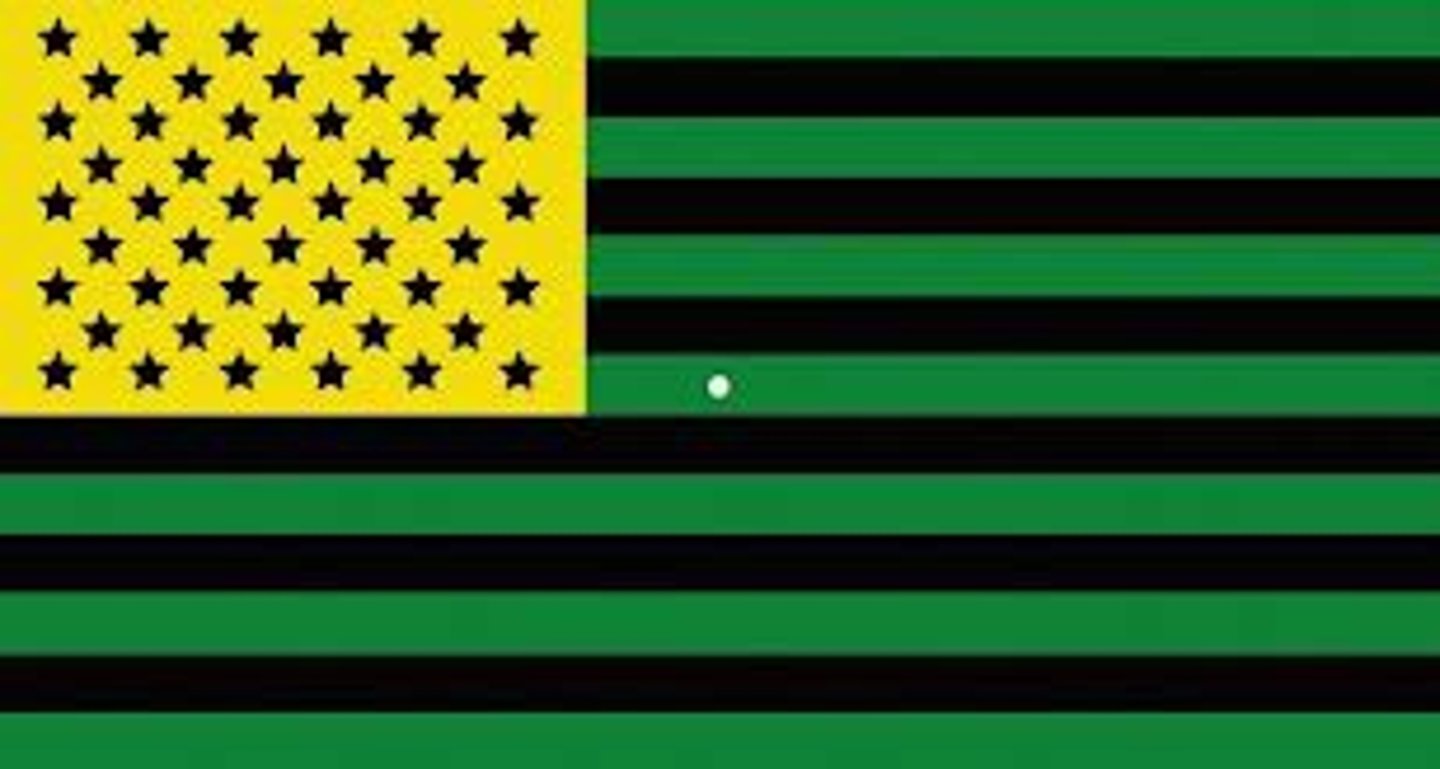
Audition(Hearing)
Humans can detect between 20 Hz and 20,000 Hz sound waves
Parts of the ear:
◦ Outer ear
◦ Middle ear
◦ Inner ear
Outer Ear
External ear flaps
Auditory canal
Tympanic membrane(eardrum)
A job of the outer ear is to channel sound waves towards the inner ear.
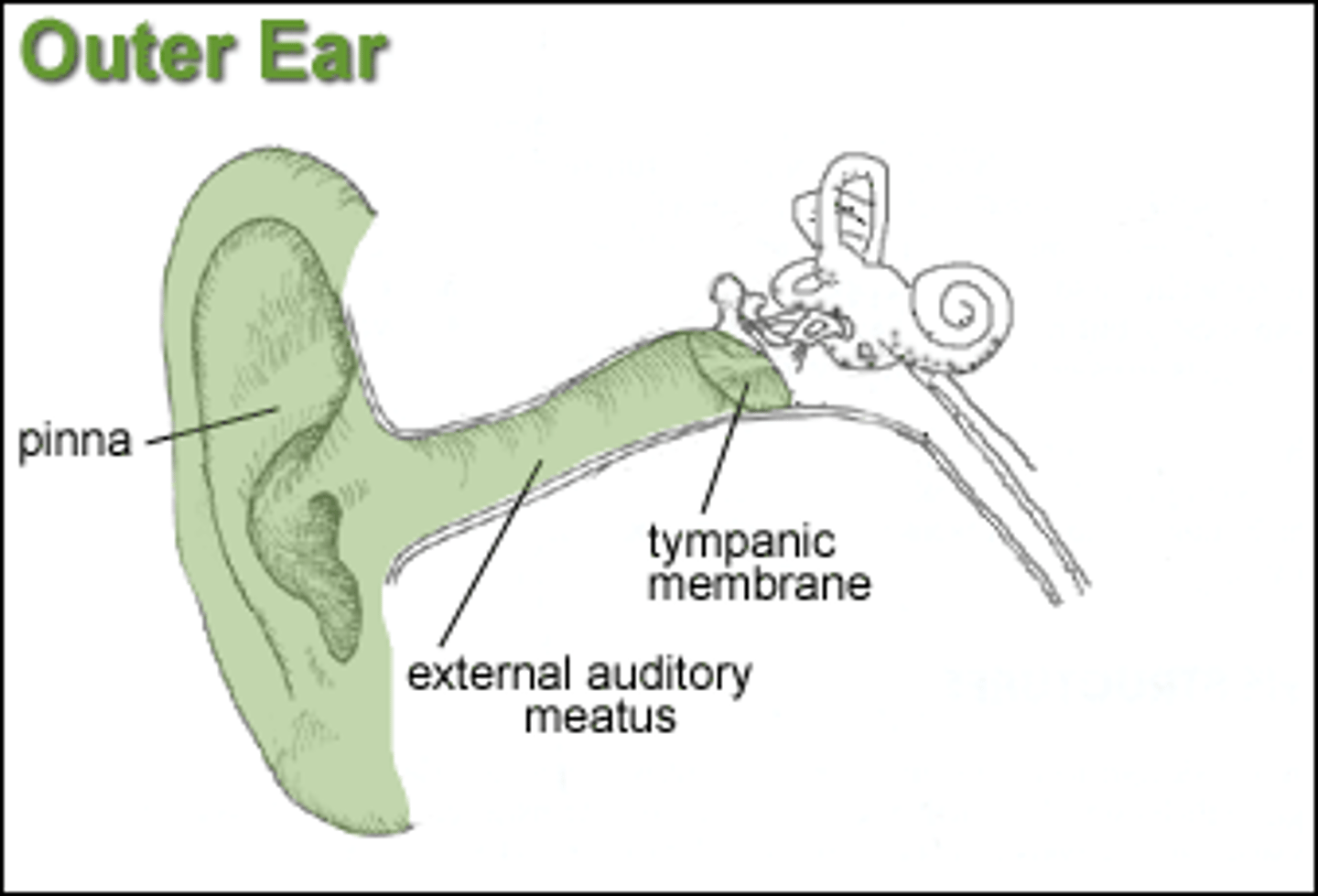
Middle Ear
Contains the ossicles, the three smallest bones in the body
◦ hammer, anvil, and stirrup
The job of the middle ear is to amplify sound waves.
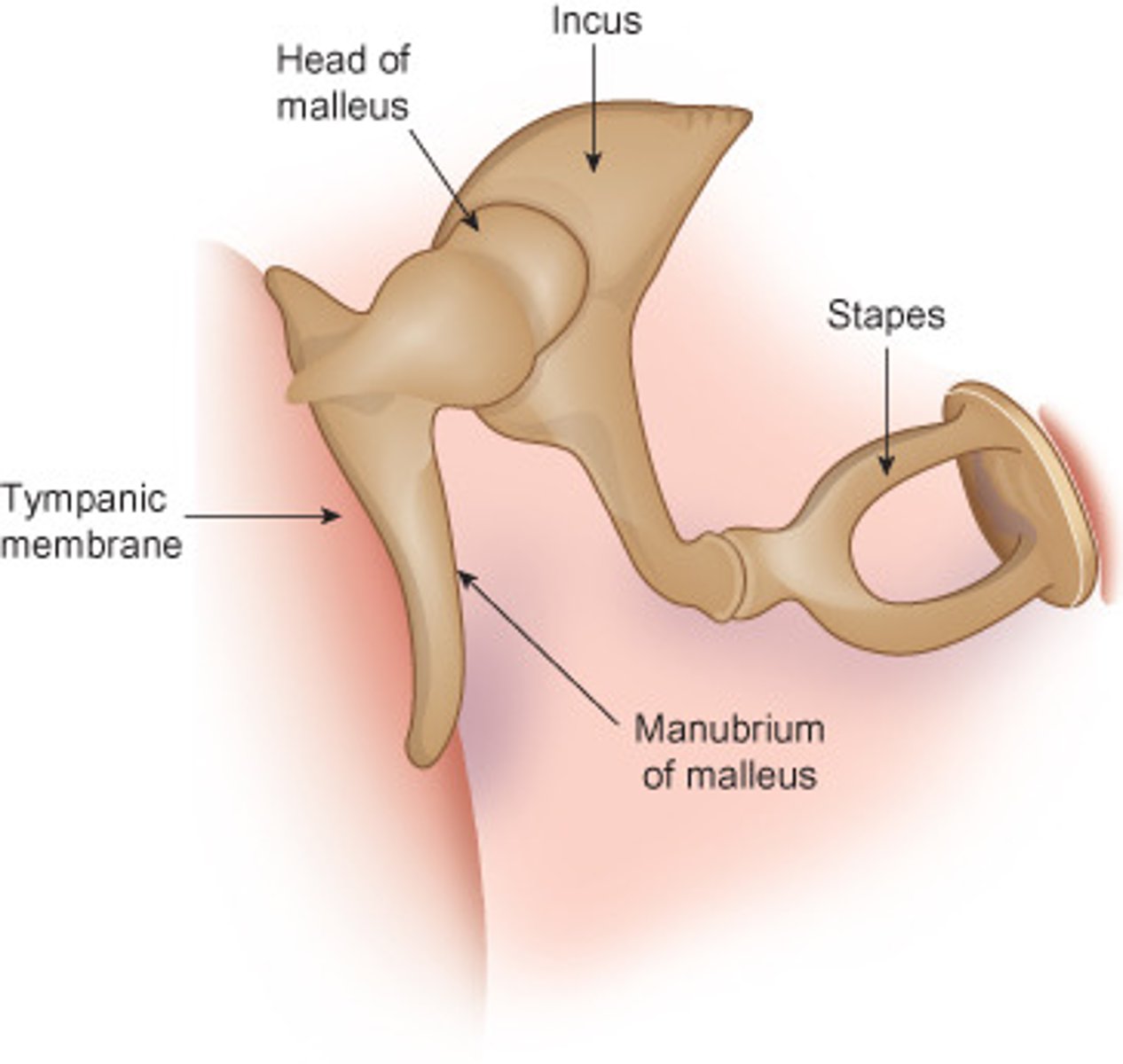
Inner ear
Has the Cochlea, Oval Window, and Basilar Membrane
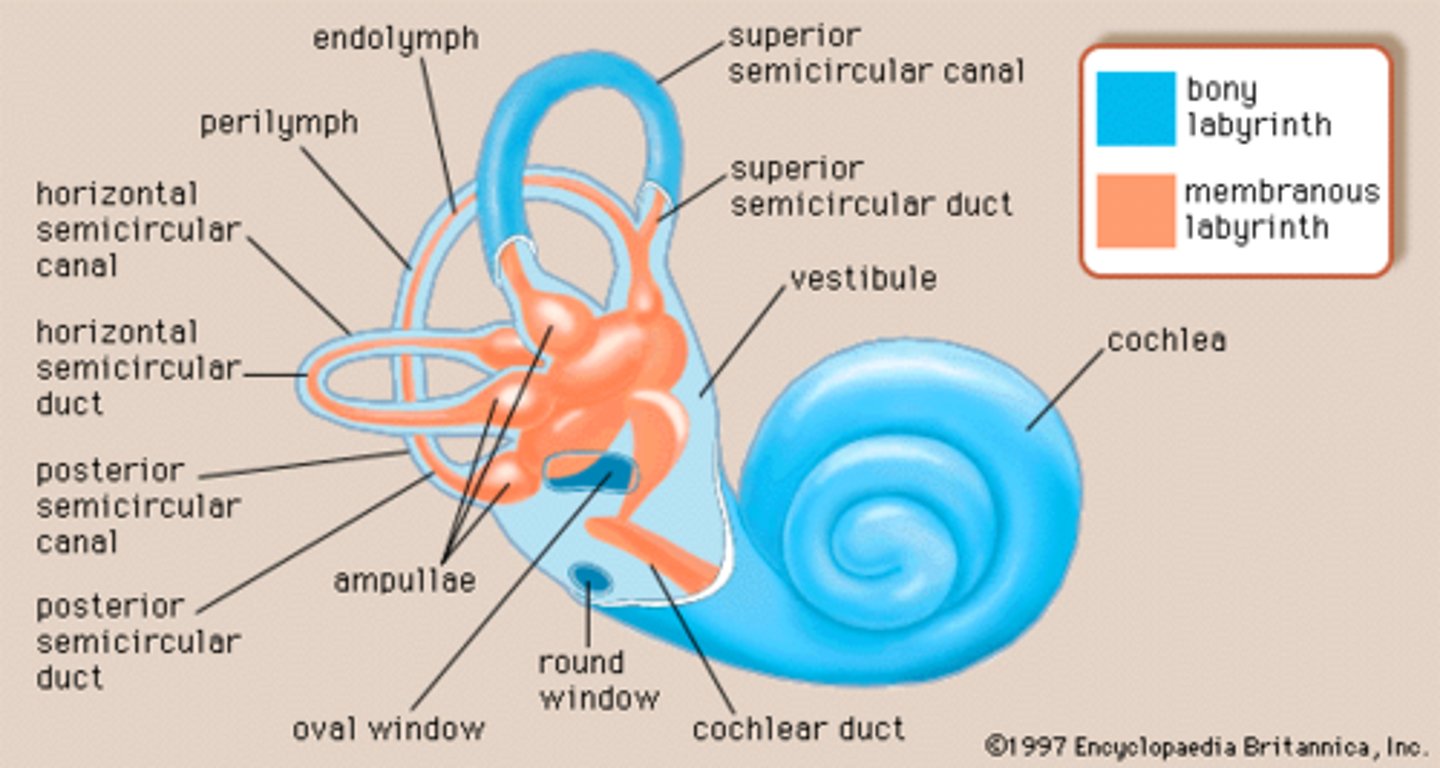
Cochlea
a snail-shaped, fluid-filled tube that contains the receptors and structures necessary for hearing
Oval Window
a thin membrane at the base of the cochlea; the stirrup strikes the oval window and causes it to vibrate
basilar membrane
membrane that "floats" in the middle of the cochlea; contains the hair cells: the receptors that transduce sound waves to action potentials as they bend
What are the three smallest bones in the body?
The ossicles: Hammer, anvil, and stirrup
Temporal/Frequency Theory
basilar membrane vibrates at frequency of sound wave.
For example, a 500 Hz sound would cause 500 action potentials.
This theory works best for lower frequency sounds (up to about 1000 Hz)
Place Theory
pitch is determined by area of maximal displacement of basilar membrane.
Compares hearing pitch to strings on a piano.
This theory best describes how we hear higher frequency sounds (above 4000 Hz)
What Hz do conversational tone range from?
Conversational tones range from about 500 - 3000 Hz (25 - 60 Db)
Low frequency is how many Hz?
100 Hz
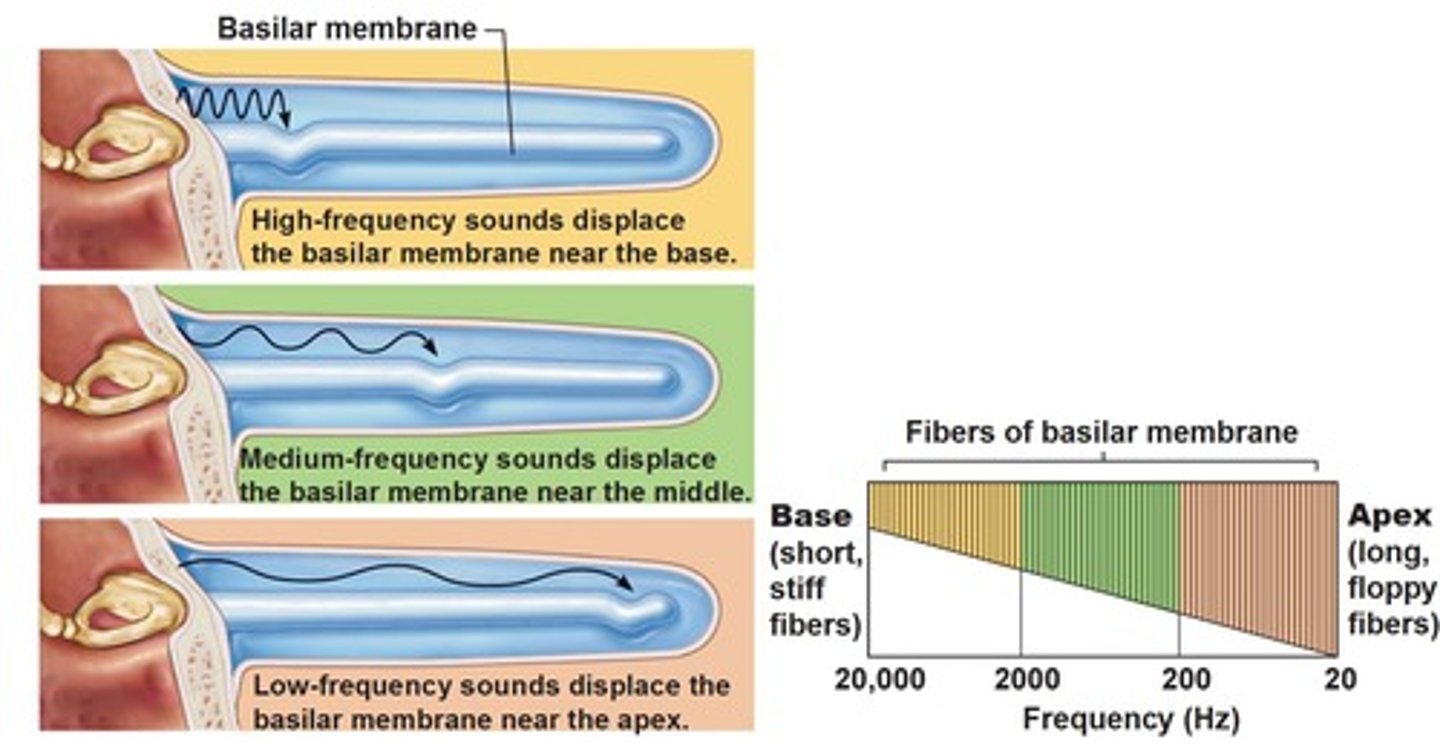
Medium frequency is how many Hz?
1,000 Hz
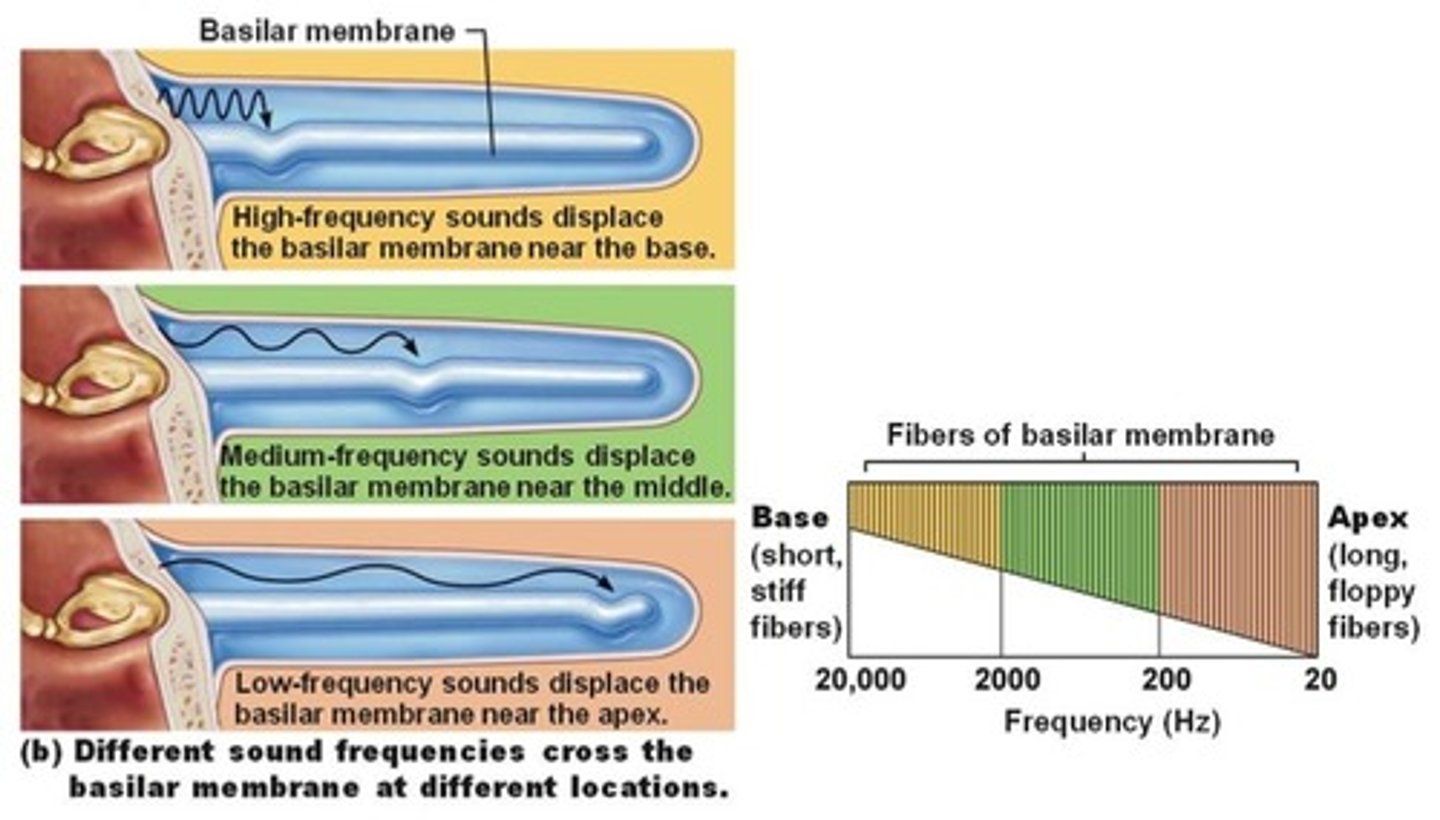
High Frequency is how many Hz?
10,000 Hz
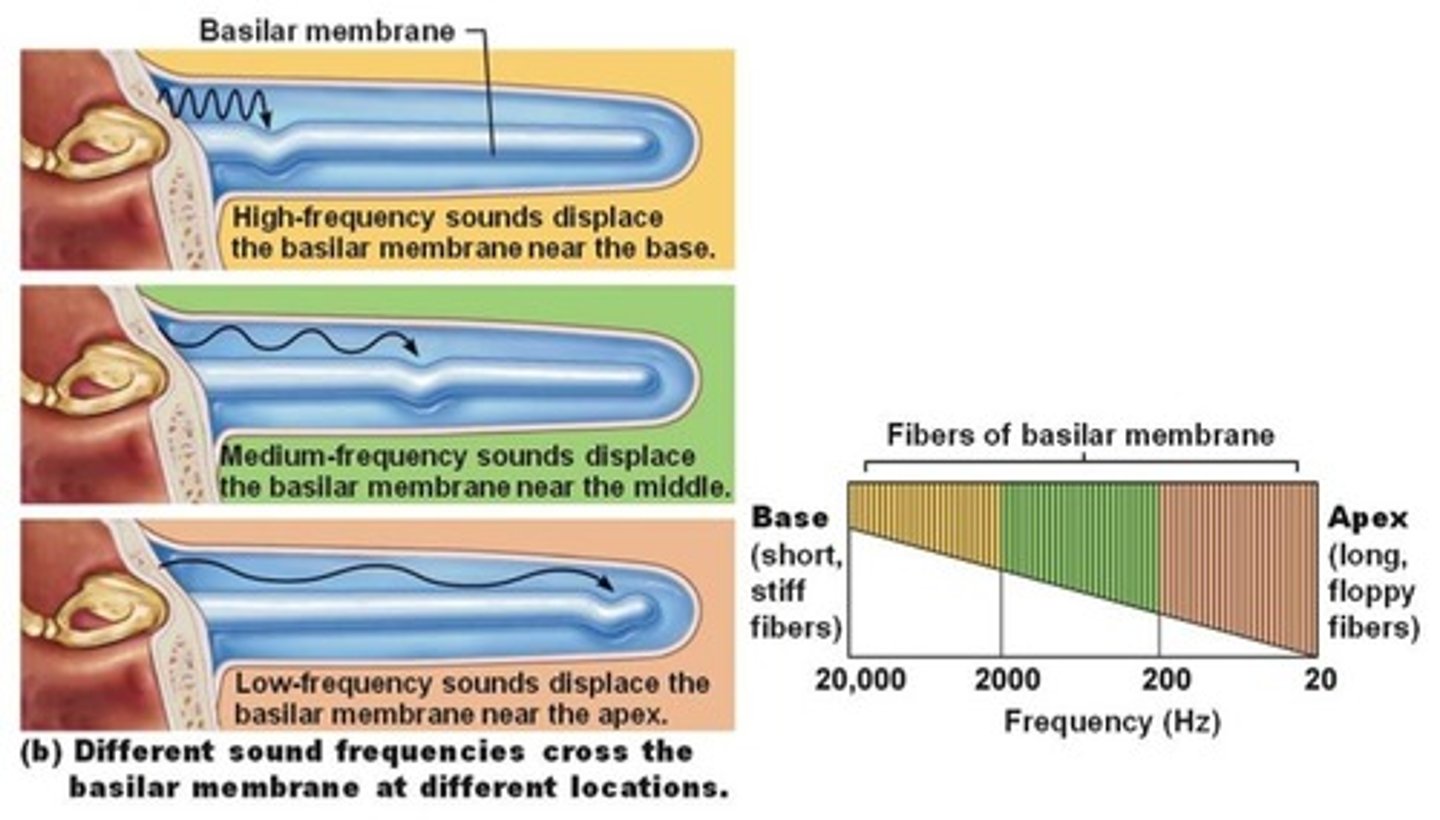
nerve deafness (sensorineural deafness)
damage to hair cells, auditory nerve, or temporal cortex; if damage is at the hair cells, a cochlear implant can help
Conduction deafness
mechanical failure (eardrum, middle ear damage, etc); often hearing aids can help amplify sound waves
Locating sounds
•The placement of the two ears allows for the localization of sound by the differential timing in the reception of sound waves
•Even the shape of our outer ears may distort sound waves enough to indicate whether a sound is originating ahead of us or behind us
What are the chemical senses?
Smell and Taste
The chemical Senses
The chemical senses are so named because molecules (chemicals)are detected by the receptor cells. The chemical senses are the most primitive of the senses and are directly tied to motivational states. Both smell and taste inform us whether to approach or avoid a particular stimulus
Taste(Gustation)
If the sense of smell is blocked in some way (as when you have a cold) foods just don't taste "right."
The sense of taste is important in determining which foods are edible.
Taste buds regenerate every two weeks or so.
The taste buds are contained in the papilla: structures on the tongue
How many taste receptors(taste buds) do humans have?
About 2,000-10,000 taste receptors
What are the four major tastes?
What has been more recently identified?
What is the possible addition?
Major tastes:
◦ Salty foods are high in sodium chloride.
◦ Sour tastes are triggered by acids.
◦ Sweet tastes are usually high in calories.
◦ Bitter tastes are often poisonous.
Recently identified:
◦ Umami taste is associated with proteins.
Possible addition:
◦ Fatty foods are also usually high in calories.
Smell (Olfaction)
Olfactory cells
Much of olfactory information is sent to the hypothalamus and other limbic system structures.
Olfactory information is also sent to an area of the prefrontal lobe, allowing for our conscious use of smell
Vomeronasal Organ
Olfactory cells
cells in nasal cavity that detect odor by responding to molecules that carry smell information. Humans have approximately 5 million receptor cells arranged on about 1,000 different receptor types, and can respond to about 10,000 smells.
Vomeronasal Organ
An area in the nasal cavity that has receptors sensitive to pheromones.
Pheromones
◦ chemicals released by an organism that acts on other organisms of that species to produce specific behavioral or physiological responses.
◦ Usually involves reproduction in some manner.
Humans and Pheromones.
What does research indicate?
We do secrete steroid molecules that resemble pheromones of other species in structure.
We do have a vomeronasal organ, although whether or not it is functional or vestigial is unknown.
Evidence for a "sex-attractant" pheromone in humans has not been validated.
We can identify individuals by smell.
Women who live in groups often begin to coordinate the onset of menstrual cycles.
A woman who sleeps with the same male over time ovulates more regularly.
Somatosensory system (Touch)
the bodily senses; discriminates touches. The somatosensory system doesn't have receptor cells that pass information to the sensory neurons; rather, the dendrites of the neurons involved in the somatosensory system transduce physical energy to neural energy themselves.
What are the divisions of Somatosensory System?
Touch(itch/tickle; touch, pressure, flutter, vibration)
Temperature Pain
Proprioception(position & movement of a body part)
Temperature extra Info
We have receptors that detect "cold" and receptors that detect "warm." However, we have no "hot" detectors. Something is perceived as hot when BOTH cold and warm receptors are stimulated at the same time.
The sensation of Pain
Pain receptors are located throughout the entire body (but not in the brain itself).Pain has motivational properties- it motivates us to remove ourselves from or avoid painful situations. Pain also affects and is affected by psychological processes, much more than the other senses.
What parts are involved in experiencing pain?
Somatosensory cortex
Limbic system & insular cortex
Prefrontal Cortex
Somatosensory cortex's job in experiencing pain
involved in the location and descriptive qualities of pain
Limbic system & Insular cortex job in experiencing pain
(in frontal lobe): involved in the motivational aspects of pain (AVOIDANCE of painful stimuli).
Prefrontal Cortex job in experiencing pain
involved in anticipating painful events and worrying about pain.
Phantom limb pain
experiencing pain in a limb (arm, leg, finger, etc)that is no longer part of the body; may be due to a reorganization of somatosensory areas responsible for the missing limb.
Modulating Pain-Endorphins
released by the periaqueductal grey in the midbrain; block pain information from reaching the cortex.
Kinesthetic sense
movement of body through space.
Proprioception
movement of joints & body position.
Vestibular Sense
Monitors head movements.
Involved in experiencing dizziness.
Principles of Perceptual Grouping
Stated by Gestalt psychologists, the principles of perceptual grouping are thought to be innate predispositions of our nervous system to organize sensory input in particular ways.
Figure/Ground
A major principle proposed by Gestalt psychologists, figure/ground refers to our innate organization of objects(figures) against a backdrop(ground).The "figure" is perceived as being distinct from surroundings; it "stands out" perceptually and is the focal point. The "ground" is everything else perceived as surrounding the figure.
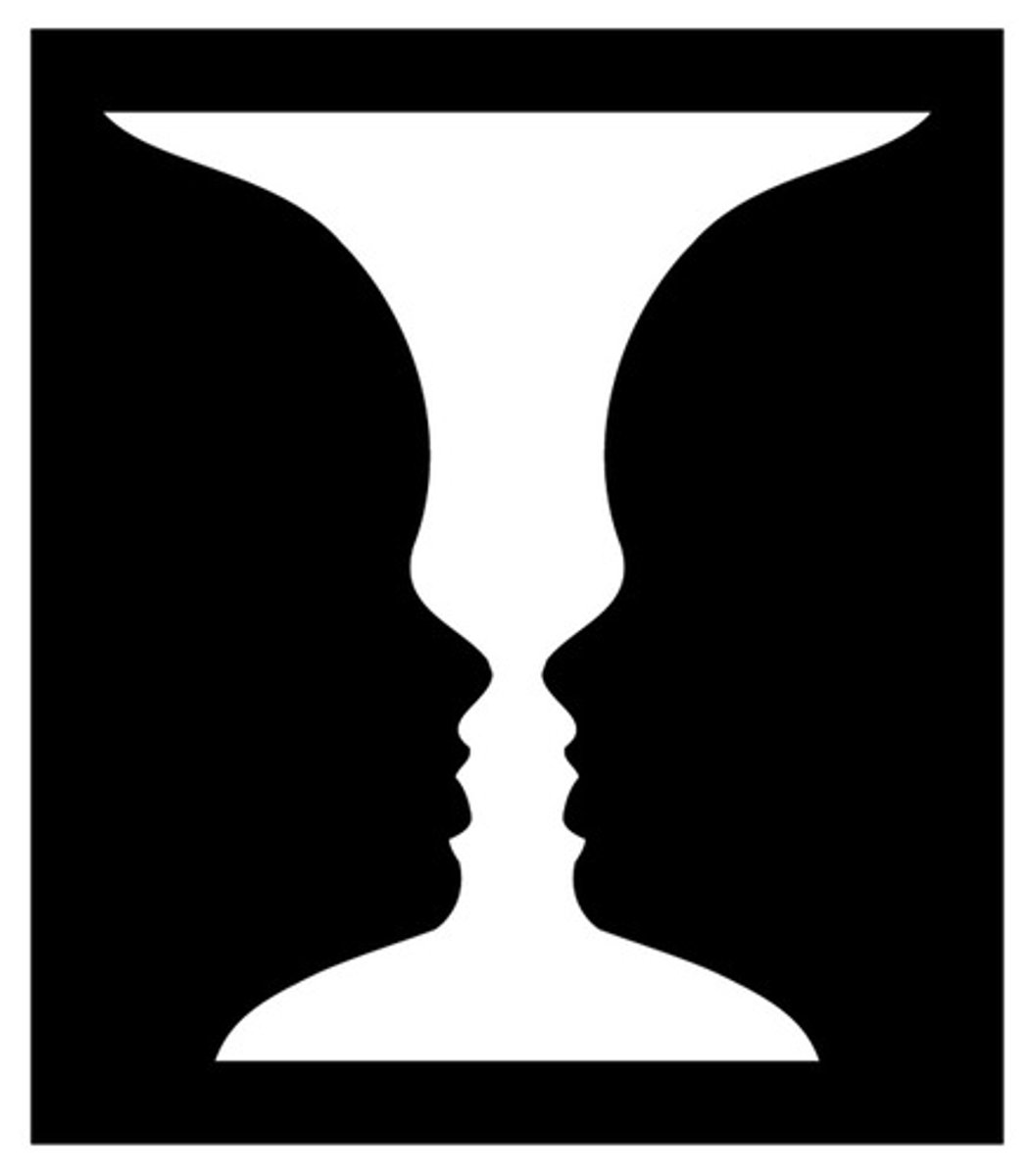
Proximity
Elements that are close together are perceived as belonging to the same object
Elements that are farther apart are perceived to belong to different objects.
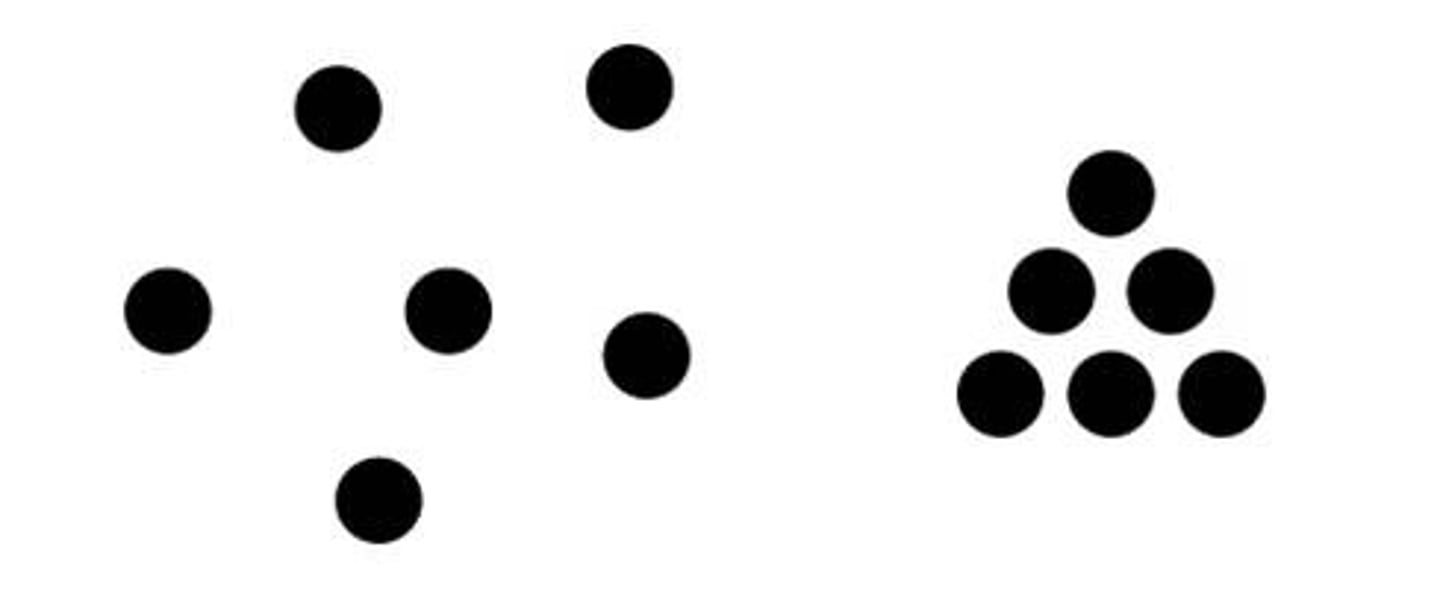
Similarity
Elements that physically resemble each other are grouped together
Disparate elements are perceived as belonging to different objects
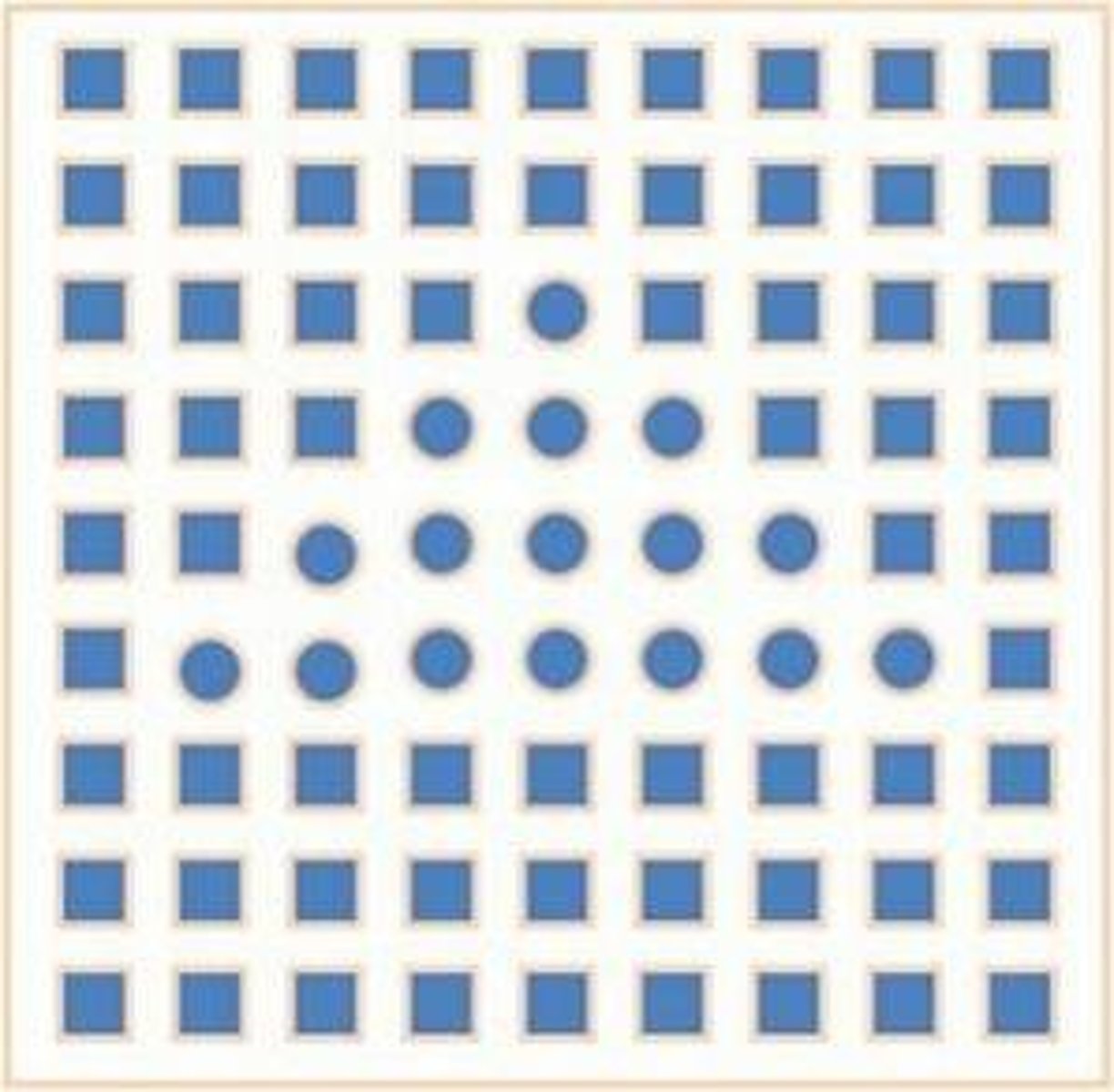
Closure
We tend to fill in gaps in borders, because objects are perceived to be completely enclosed by borders.
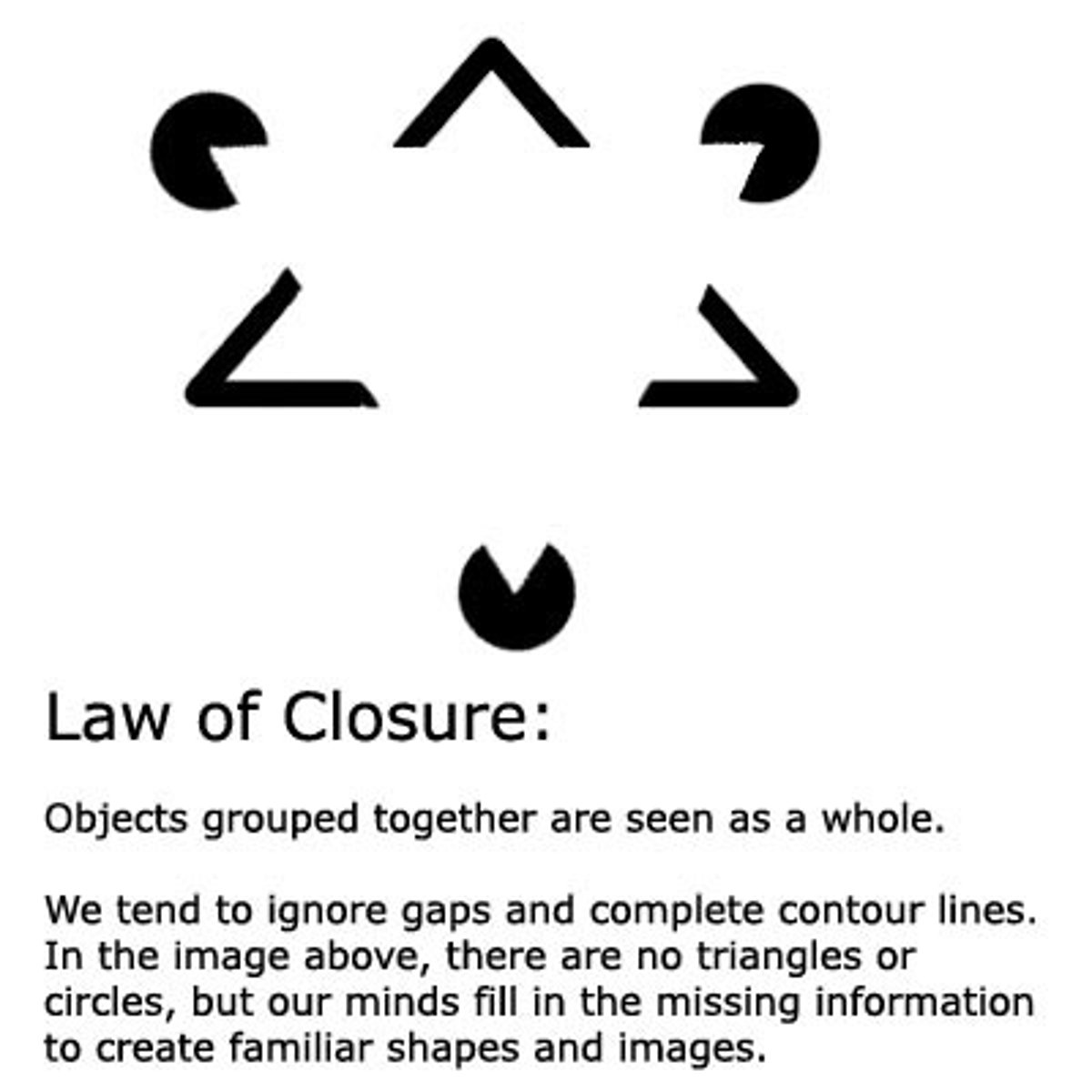
Continuity
Lines tend to be perceived in smooth, continuous patterns, rather than oddly-shaped turns and angles.
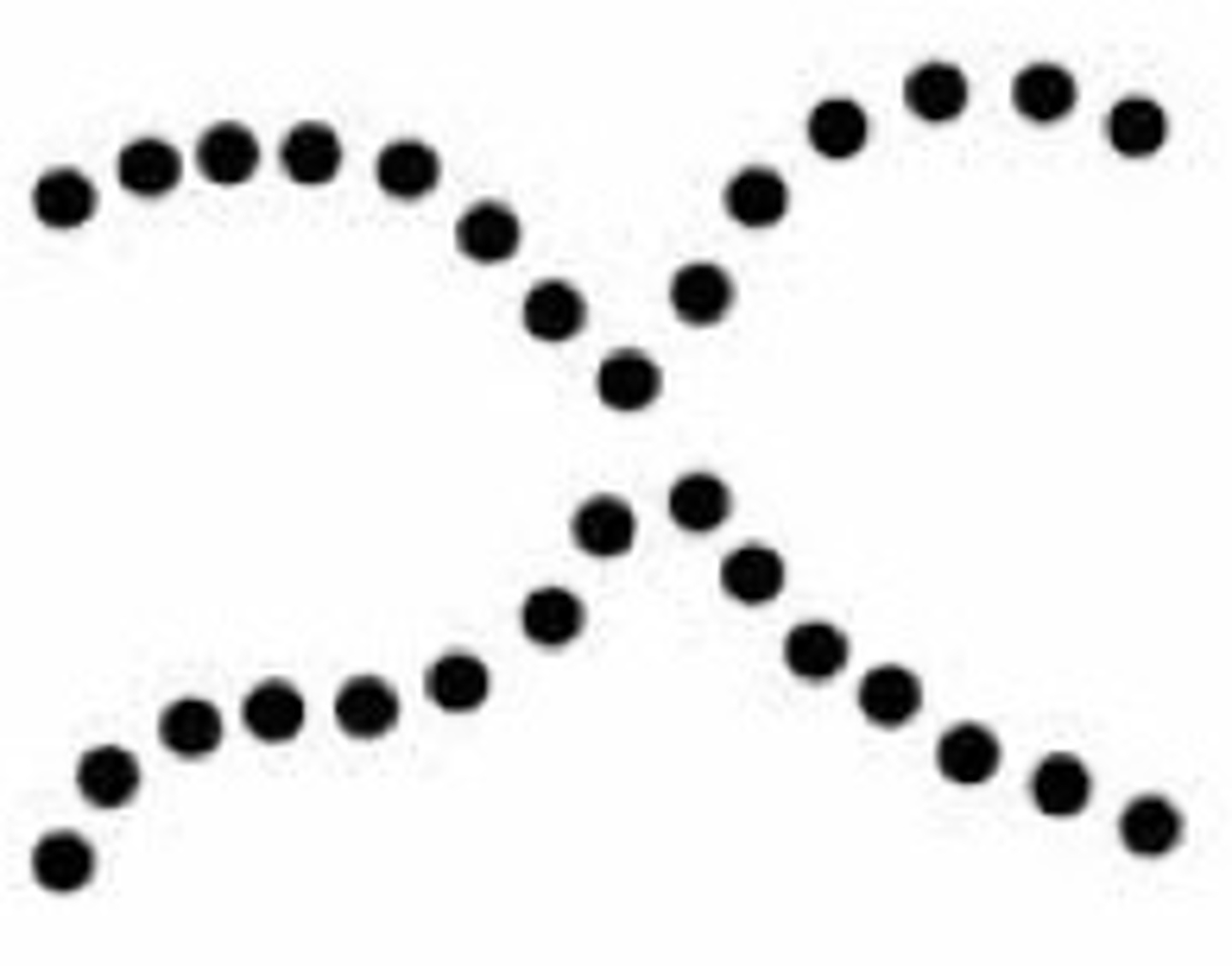
Common Movement (Fate)
Features that move together are grouped together.
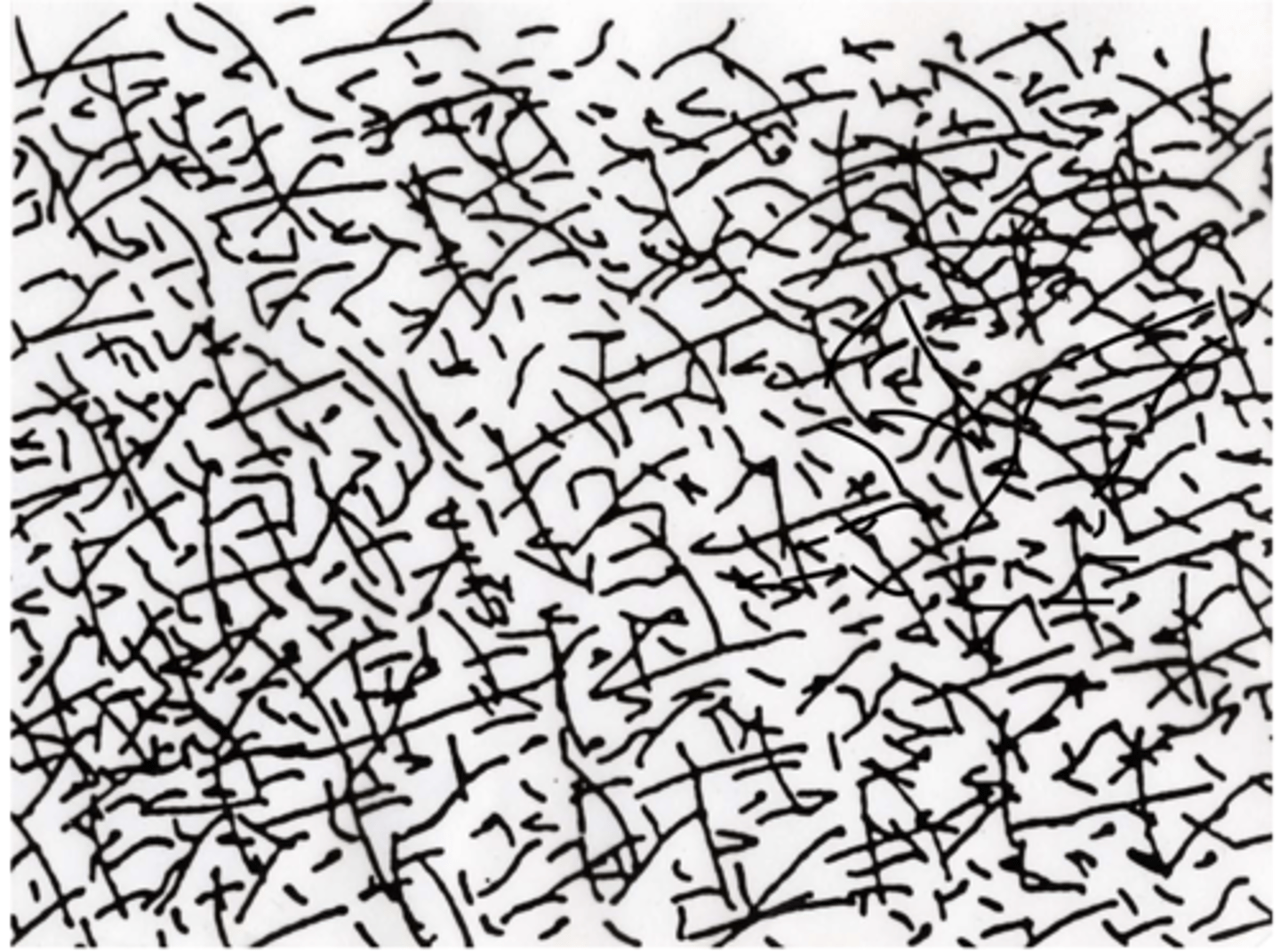
Depth Perception
Refers to seeing objects in three dimensions.
Our ability to perceive depth allows us to judge distances.
We make use of two sets of cues to distinguish depth - binocular cues and monocular cues.
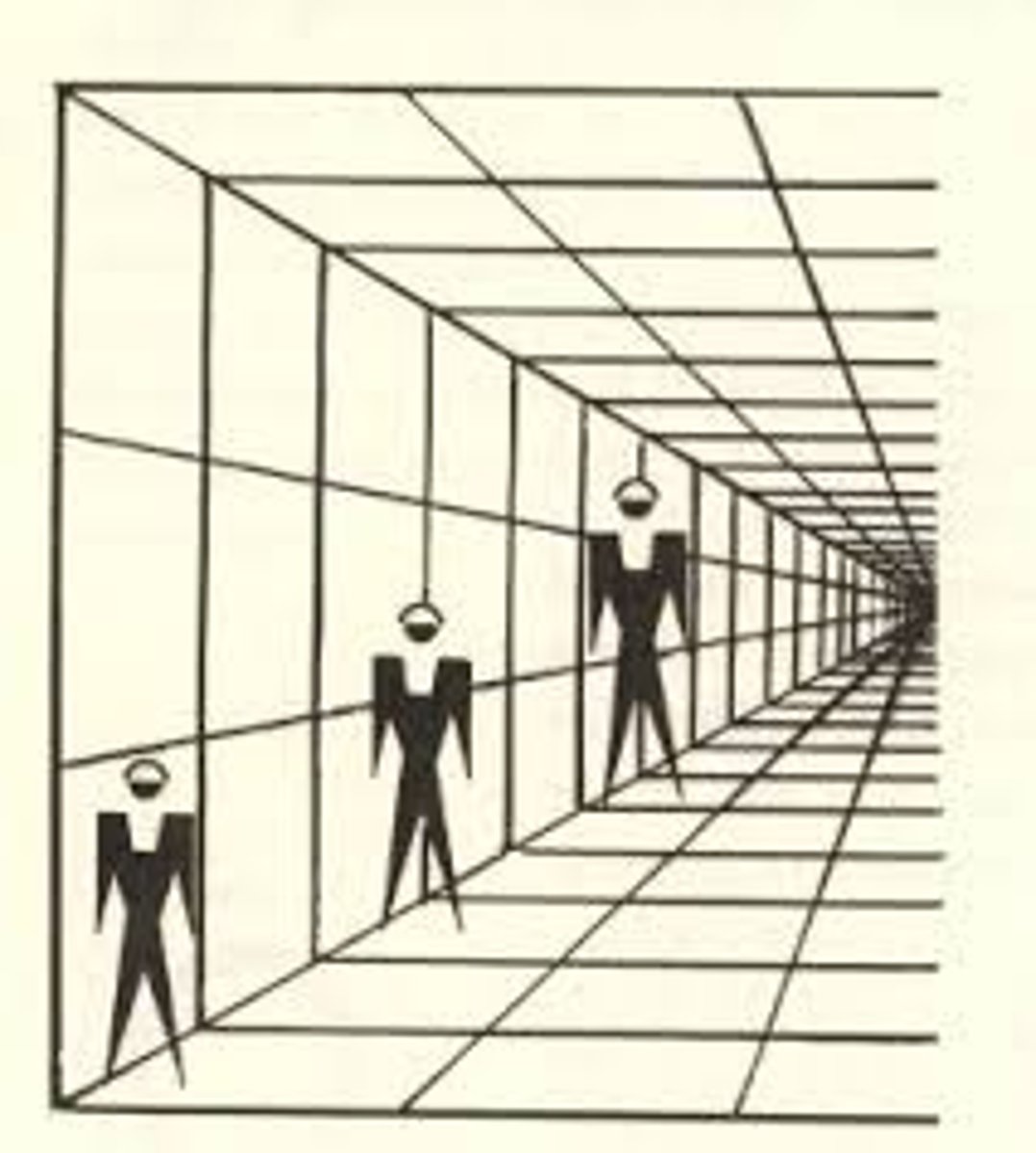
Binocular Cues
Require Two eyes
◦ Retinal (binocular) disparity
◦ Eye convergence
Retinal (Binocular) Disparity
Each eye, because it is separated from and angled slightly differently from the other, receives visual information at a different location than the other.
The greater the difference in angle between the two eyes, the closer object.
The less disparity in angle, the farther away the object is.

Eye Convergence
Reflects how much the eyes need to come together(or converge) to focus on object.
The greater the convergence, the closer the object.
Not a very good cue; it is useless for objects more than a few feet away
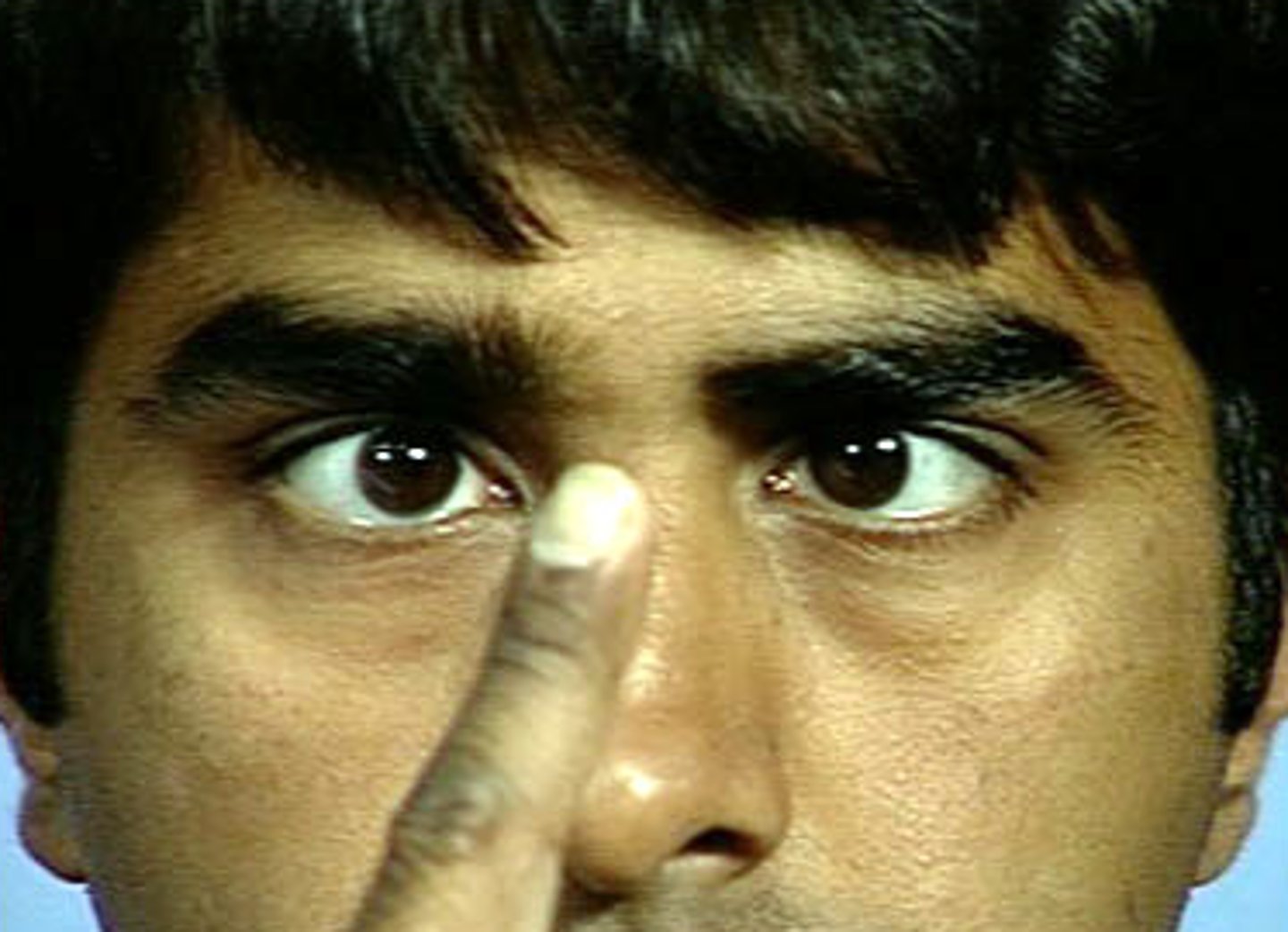
Monocular Cues
Only require one eye.
The monocular cues have been used for centuries in artistic endeavors to create a sense of depth using only two dimensions.
Interposition (Occlusion)
Closer objects block the objects located behind them.

Linear Perspective
Parallel lines converge (come together) in the distance
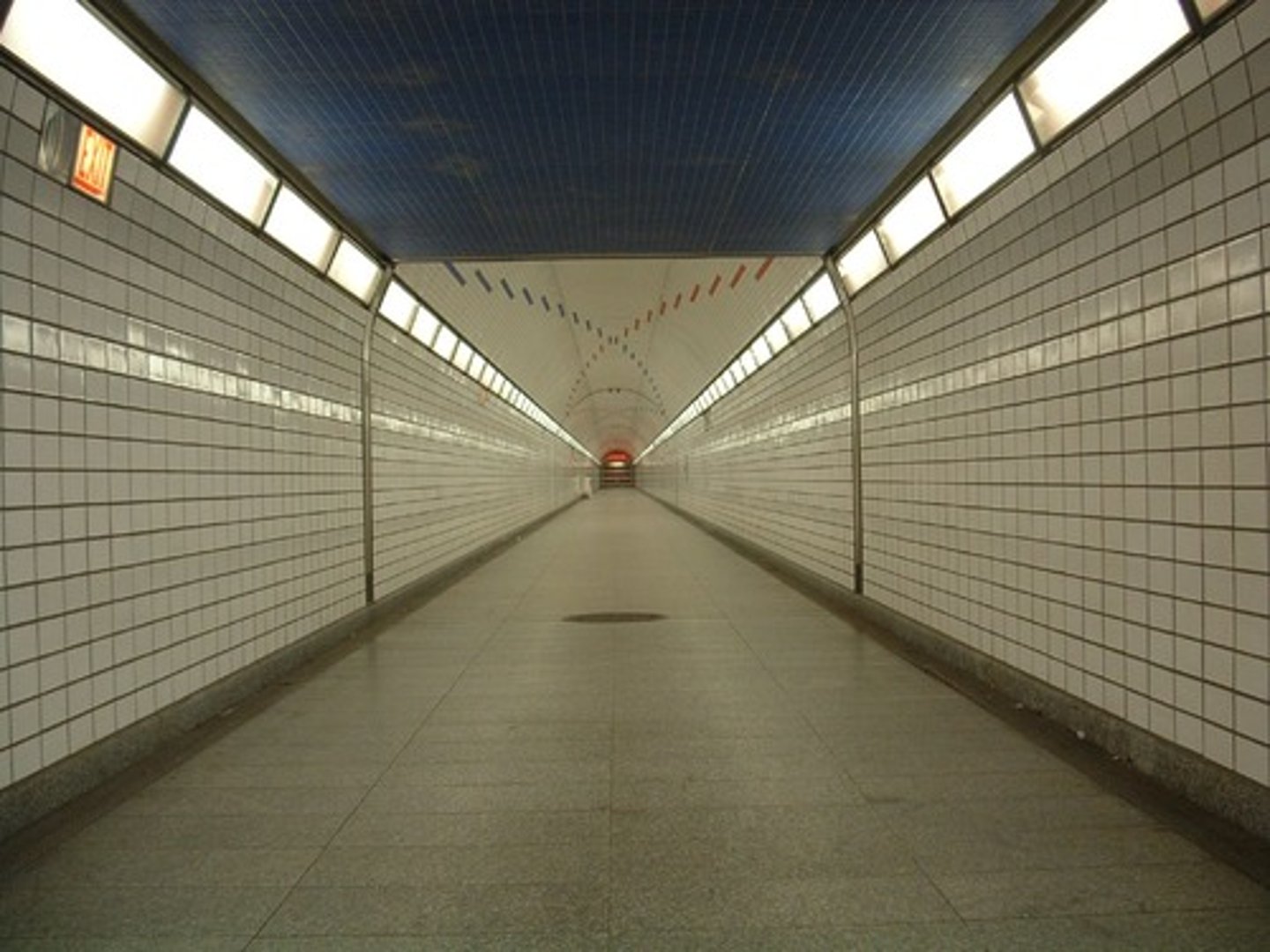
Texture Gradient
Elements of a regular texture will get smaller as they get further away.
Closer objects have more texture; objects further away appear smoother.

Relative Size
When viewing objects of approximately the same size, the one creating the larger retinal image is closer.
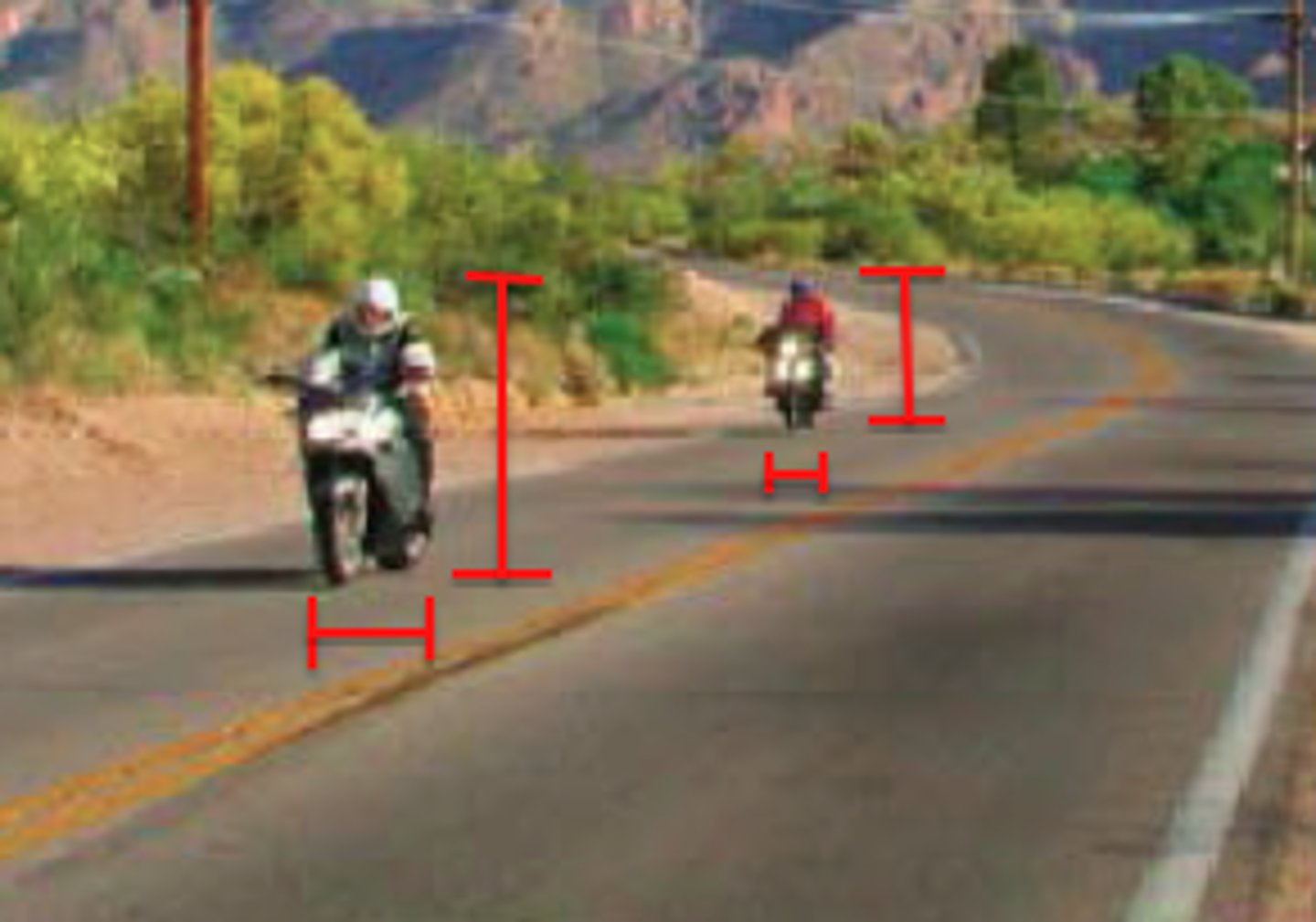
Relative Height
When viewing objects on a horizontal plane, objects that appear lower on the plane are closer; objects higher on the plane are further away.
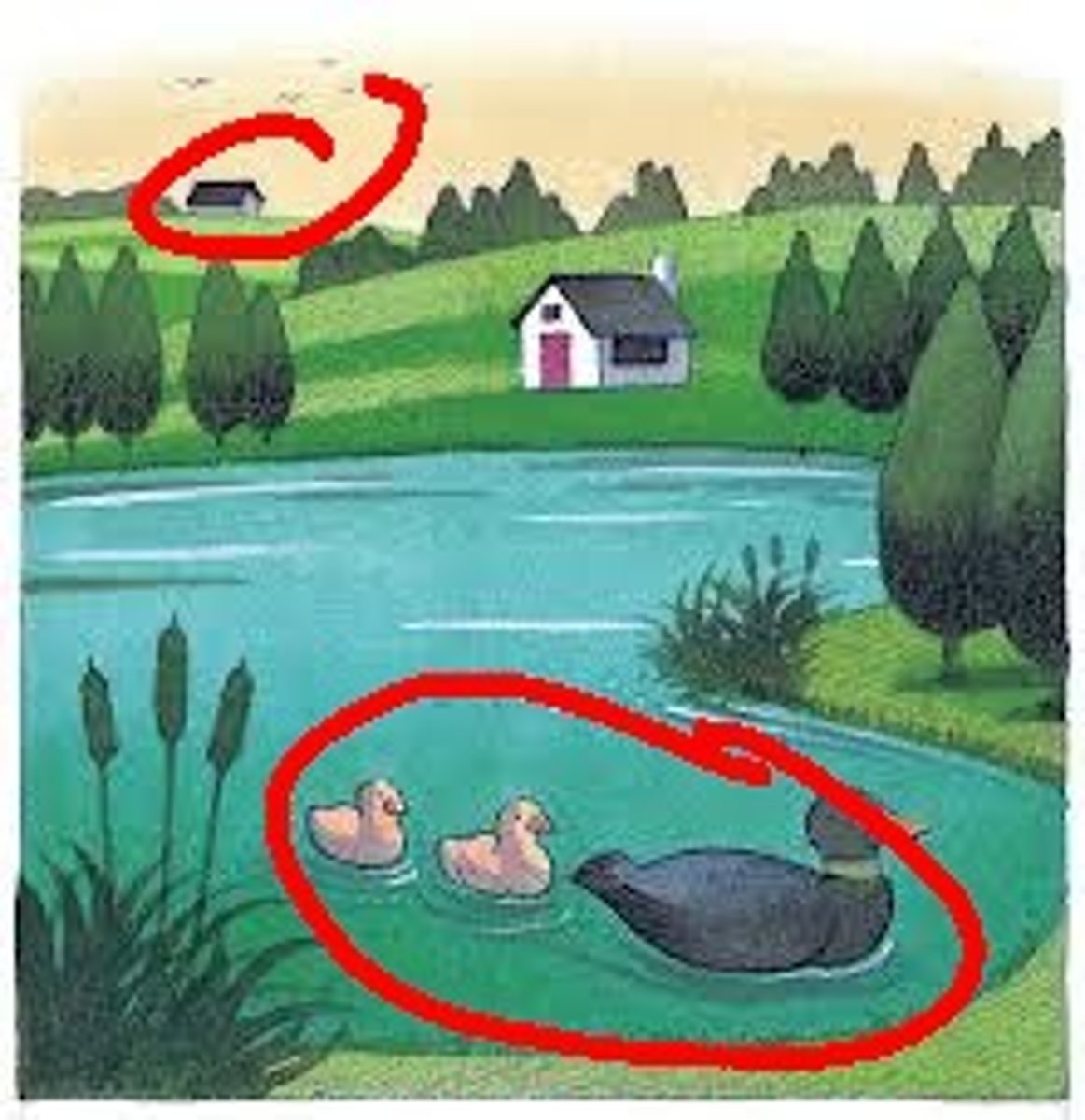
Relative brightness
Shadowing
The use of shadowing can be a cue to distance.
*Search for Picture
Relative Clarity
Ariel perspective
Objects far in the distance are "fuzzy" and bluer.

Motion Parallax
An additional monocular cue is motion parallax, in which head movement can contribute to depth cues.
Objects closer to the viewer move faster across the retina of the eye than objects that are farther away.
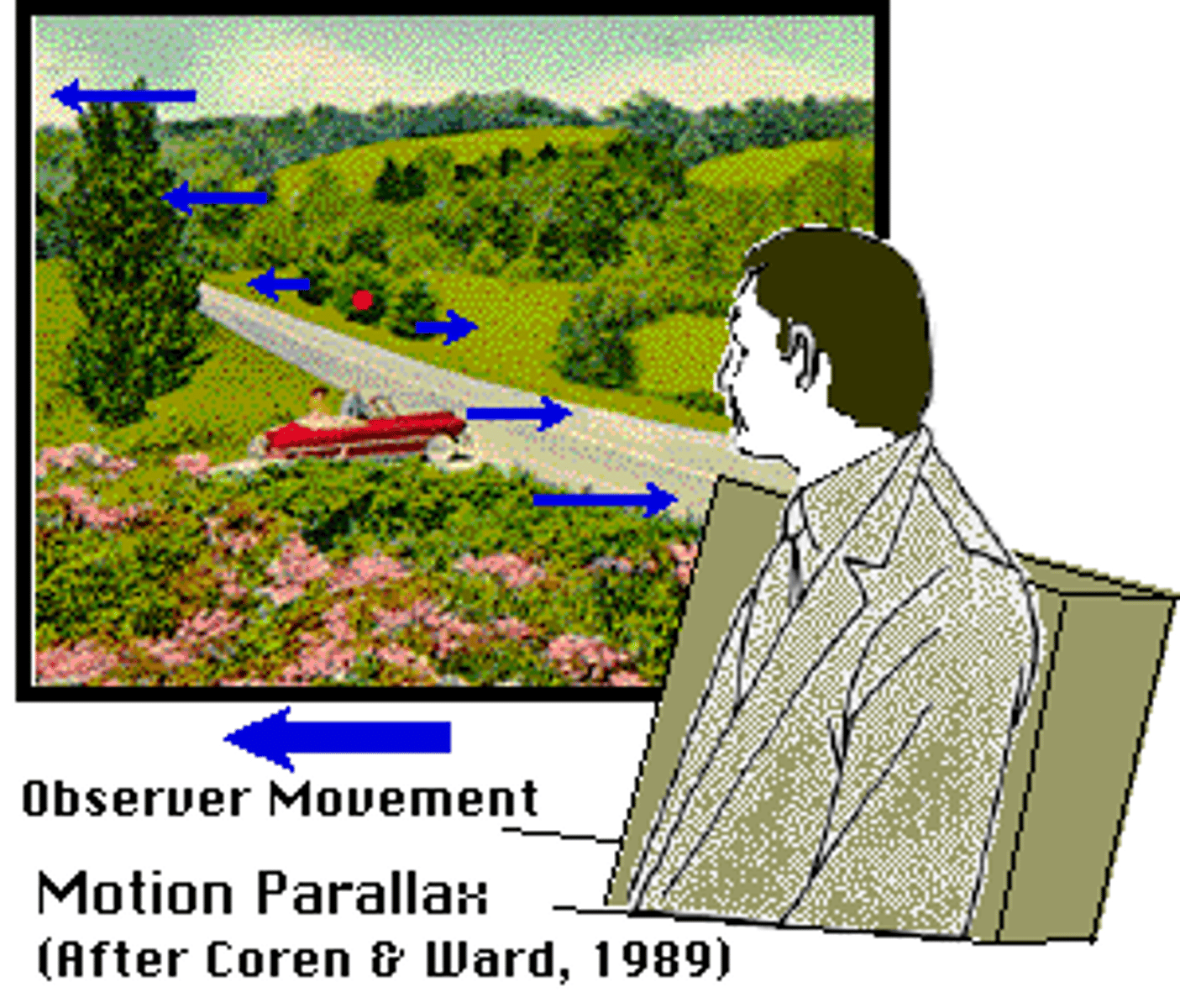
Constancies
Objects retain their shape, size, color and brightness, even if the actual image on the retina is distorted.
shape constancy
a book on a desk remains the same shape, regardless if you look at it straight on or walk around the desk.

Size constancy
light from objects in the distance takes up less room on the retina. However, we perceive them as maintaining their size as they move away, not as shrinking.

Color and brightness constancy
both color and brightness reaching our eyes change in different lighting situations (a car driving under a bridge, for example);however, the color and brightness of objects are perceived as remaining the same.
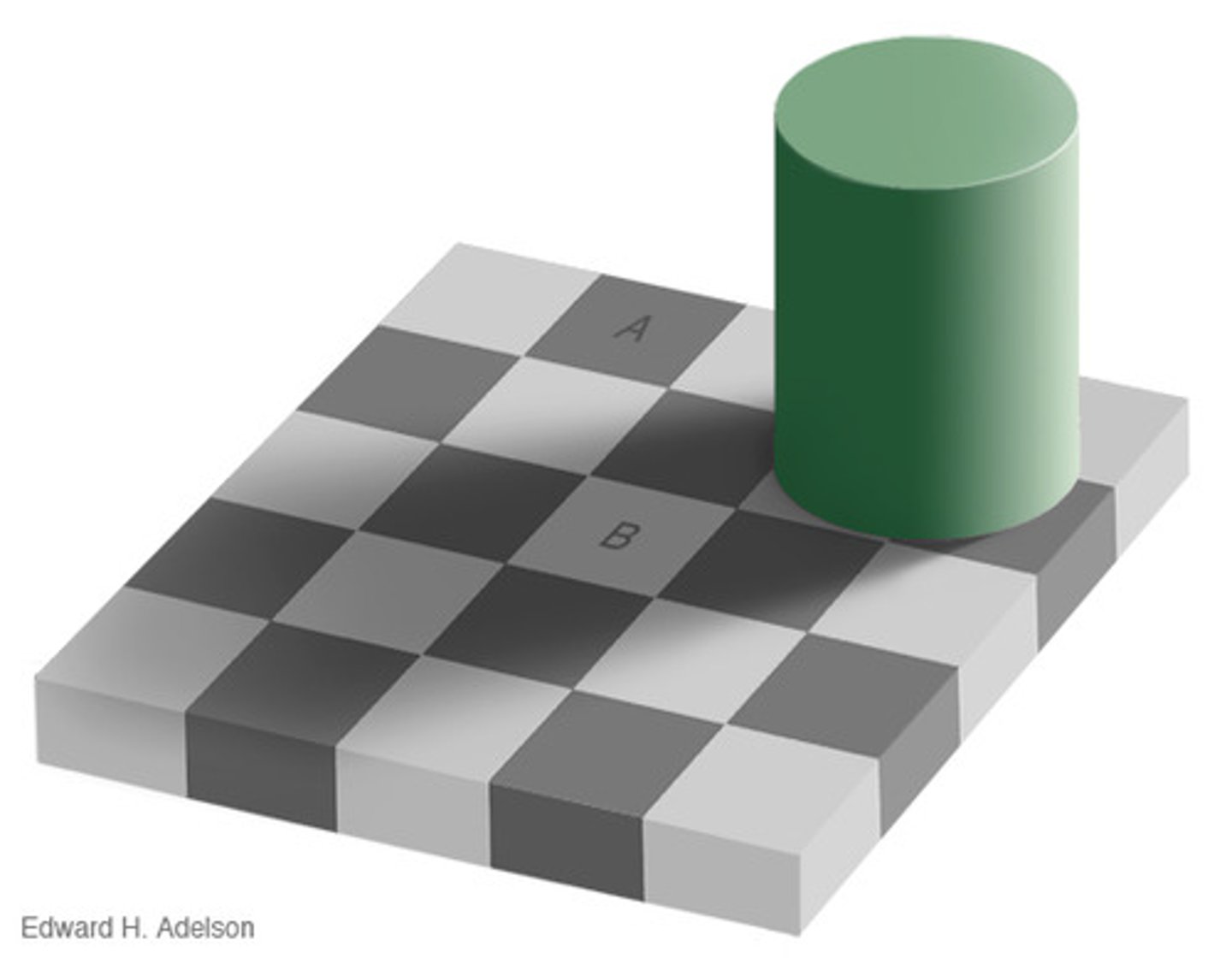
Illusions
The perceptual illusions play on depth cues, constancies, and cultural experiences.
Ames Room
Trapezoidal room; creates an optical illusion with one large and one small person
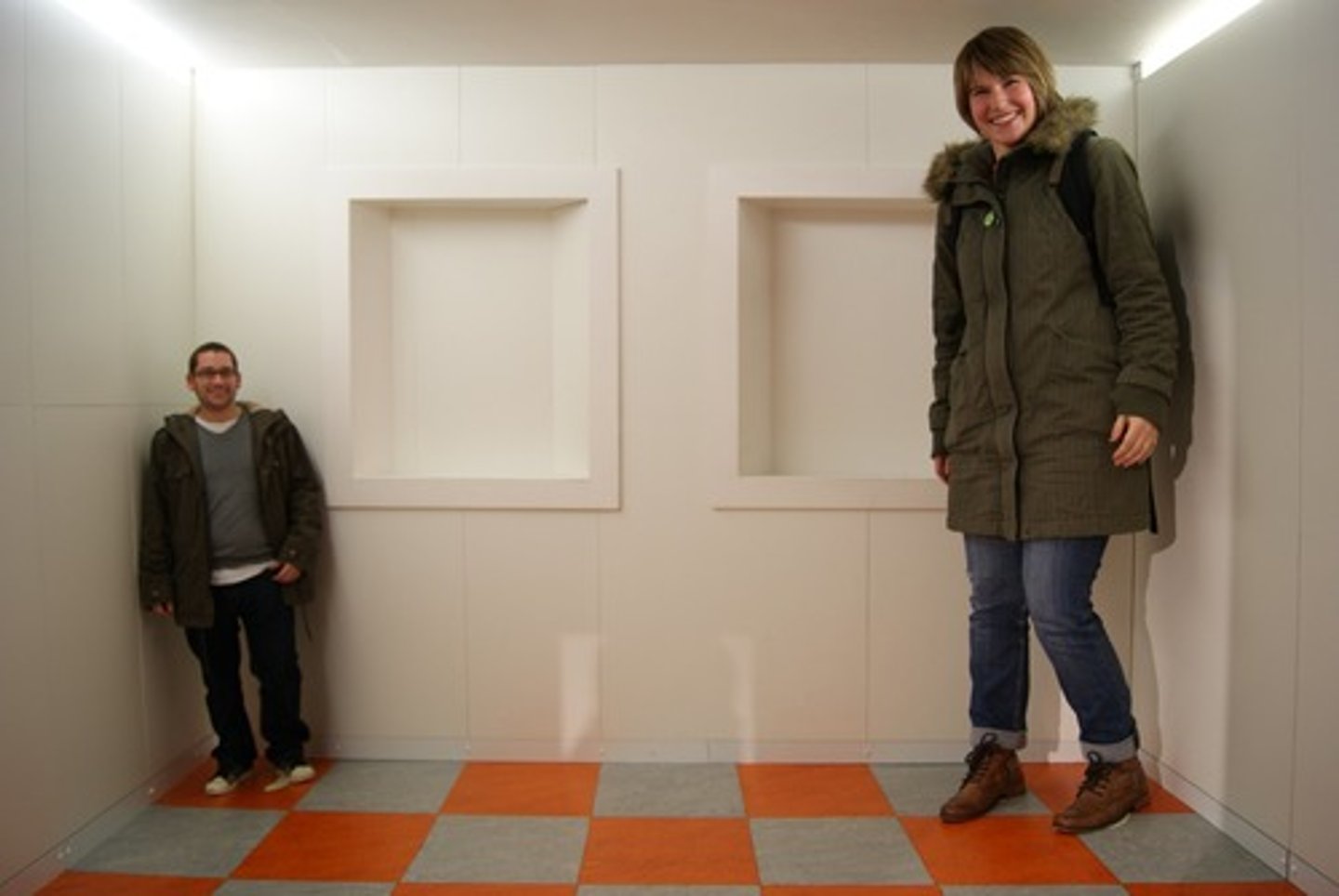
Muller-Lyer Illusion
illusion of line length that is distorted by inward-turning or outward-turning corners on the ends of the lines, causing lines of equal length to appear to be different
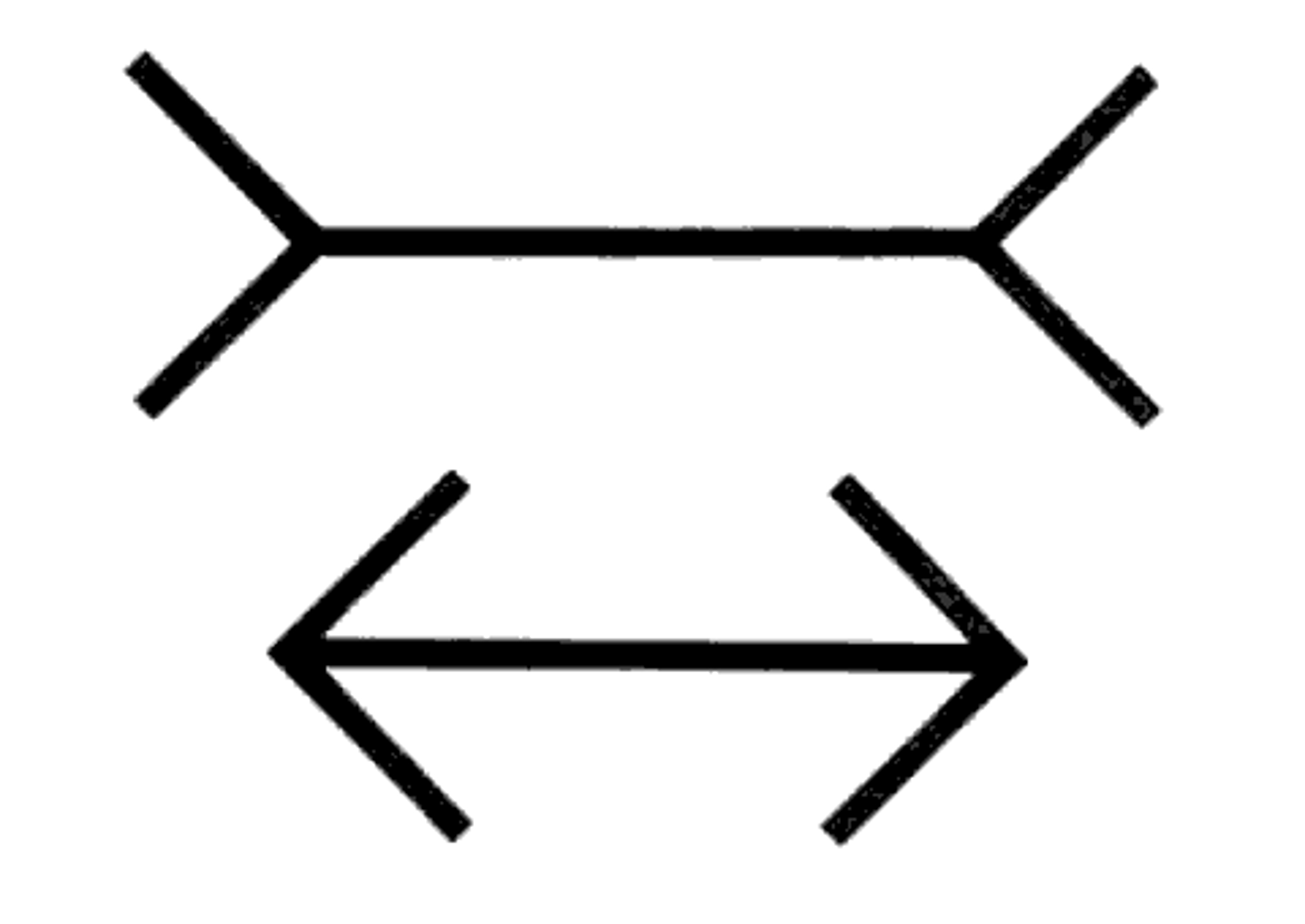
Poggendorf Illusion
Is a geometrical-optical illusion that involves the misperception of the position of one segment of a transverse line that has been interrupted by the contour of an intervening structure
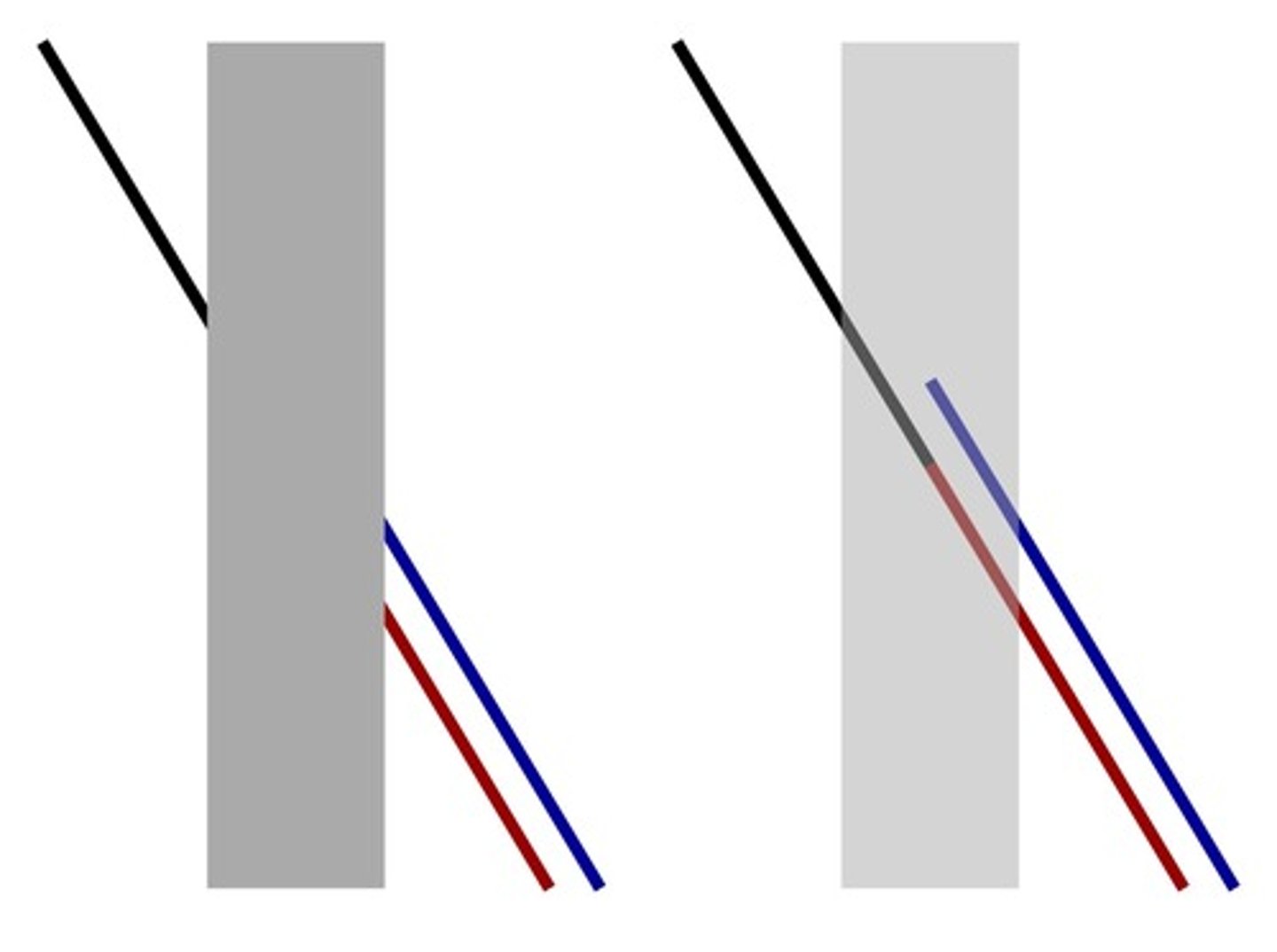
Ponzo illusion
An illusion of size in which two objects of equal size that are positioned between two converging lines appear to be different in size. Also called the railroad track illusion.

moon illusion
A visual illusion involving the misperception that the moon is larger when it is on the horizon than when it is directly overhead.
